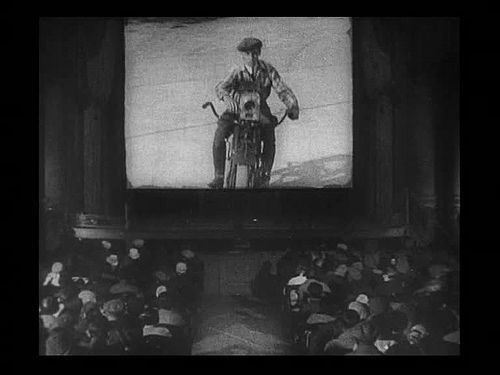![[BKEYWORD-0-3] Comparative Analysis Of Dziga Vertovs Man](https://www.writework.com/uploads/3/36181/english-frame-film-man-movie-camera-dziga-vertov-espanol-sce.jpg)
Comparative Analysis Of Dziga Vertovs Man - consider, that
No Comments The producer, Dziga Vertov, does not take into consideration the fact that the human eye fixes for a certain space of time that which holds the attention. The film, originally released in , was silent and accompanied in theaters with live music. To capture this break from the set standards Vertov filmed life over the course of five to six years then edited down the film and added a score. Working within a Marxist ideology, Vertov strove to create a futuristic city that would serve as a commentary on existing ideals in the Soviet world. Dziga Vertov's Man With A Movie Camera is considered one of the most innovative and influential films of the silent era. Check out our editors' picks for the movies and shows we're excited about this month, like Mortal Kombat, "Them," and Stowaway. Known in the NYC film scene for his knowledge and experience in film-making and his creative problem-solving skills…Richard Roepnack is the Man with a Movie Camera. All and every is a part of great unity. He plays a humble street photographer who is smitten with a pretty secretary and follows her back to the newsreel office where she works.Comparative Analysis Of Dziga Vertovs Man - consider
It introduces the protagonist, Hans Castorp, the only child of a Hamburg merchant family. Following the early death of his parents, Castorp has been brought up by his grandfather and later, by a maternal uncle named James Tienappel. Castorp is in his early 20s, about to take up a shipbuilding career in Hamburg, his home town. Before beginning work, he undertakes a journey to visit his tubercular cousin, Joachim Ziemssen, who is seeking a cure in a sanatorium in Davos , high up in the Swiss Alps. In the opening chapter, Castorp leaves his familiar life and obligations, in what he later learns to call "the flatlands", to visit the rarefied mountain air and introspective small world of the sanatorium. Castorp's departure from the sanatorium is repeatedly delayed by his failing health. What at first appears to be a minor bronchial infection with slight fever is diagnosed by the sanatorium's chief doctor and director, Hofrat [nb 1] Behrens, as symptoms of tuberculosis. Castorp is persuaded by Behrens to stay until his health improves.Agree: Comparative Analysis Of Dziga Vertovs Man
| ANIMAL ABUSE IN SERIAL KILLERS | The Things They Carried Reflective Essay |
| Comparative Analysis Of Dziga Vertovs Man | 777 |
| PATHOS IN BARRY LOPEZS LIFE | 4 days ago · The producer, Dziga Vertov, does not take into consideration the fact that the human eye fixes for a certain space of time that which holds the attention. The film, originally released in , was silent and accompanied in theaters with live music. To capture this break from the set standards Vertov filmed life over the course of five to six years then edited down the film and added a score. 2 days ago · Great American Melodramatic Theatre Analysis. The Man with the Movie Camera; The Artist This chapter conducts a comparative study of two films, The Man with the Movie Camera (Vertov, ) and The Artist (Hazanavicius, ), examining how they reflect cinematic technical developments of the ss. Director Dziga Vertov depicted one. The Magic Mountain (German: Der Zauberberg, pronounced [deːɐ̯ ˈt͡saʊ̯bɐˌbɛʁk] ()) is a novel by Thomas Mann, first published in German in November It is widely considered to be one of the most influential works of twentieth-century German literature.. Mann started writing what was to become The Magic Mountain in It began as a much shorter narrative which revisited in a Cited by: |
| Persuasive Essay On High School Recess | Social Justice In Martin Luther Kings I Ve Been To The |
| Heroin And The War On Drugs Analysis | 4 days ago · Großstadt, ) and Dziga Vertov (Man with a Movie Camera, ). The avant-garde genre of the city film is usually identified in terms of the emergence of a new visual language that tried to capture the distinct modern experience of urban life, . PAPER: An Introduction to Dziga Vertov’s film ‘Man with a movie Camera’ (). PAPER: Comparative study of rmt.edu.pkr-Bresson’s photographic work in Europe and USA as presented in the editions ‘Europeans’ and ‘America in Passing.’ ()Title: Art Director | Communication . The Magic Mountain (German: Der Zauberberg, pronounced [deːɐ̯ ˈt͡saʊ̯bɐˌbɛʁk] ()) is a novel by Thomas Mann, first published in German in November It is widely considered to be one of the most influential works of twentieth-century German literature.. Mann started writing what was to become The Magic Mountain in It began as a much shorter narrative which revisited in a Cited by: |
Comparative Analysis Of Dziga Vertovs Man Video
Soviet Montage: Crash Course Film History #8 Comparative Analysis Of Dziga Vertovs Man
India: One http://rmt.edu.pk/nv/custom/evaluating-the-limitations-of-market-research/recycling-essays.php the Leaders of the Film Production Words 11 Pagesthe city of Bombay had films produced a variety of films in the same area as where the Lumiere brothers had there first film screened in India.
The next year, the Analyxis featured show was presented at the Calcutta Star Theatre.

The first bioscopes were shown in the theatres in Kolkata during this time as well. The Indian photographer, Hiralal Sen filmed the scenes from a show named The Flower of Persia and The Wrestlers, produced by Bhatavdeker during his first few months there.]

One thought on “Comparative Analysis Of Dziga Vertovs Man”